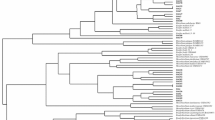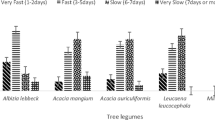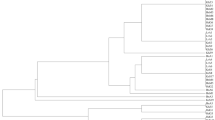Abstract
Eighteen isolates of rhizobia isolated from root nodules of Colutea arborescens (Bladder senna) grown in different soils of the eastern area of Morocco were characterized by phenotypic and genomic analyses. All the isolates characterized were fast growers. This is may be due to the isolation procedures used. The phenotypic, symbiotic and cultural characteristics analyzed allowed the description of a wide physiological diversity among tested isolates. The results obtained suggest that the phenotype of these rhizobia might have convergent evolved to adapt the local conditions. The genetic characterization consisted in an analysis of the rep-PCR fingerprints and the PCR-based RFLP of the 16S rDNA patterns. The 16S rDNA of six isolates representing the main ribotypes obtained by the PCR-based RFLP was sequenced. A large diversity was observed among these rhizobia, and they were classified as different species of the genera Rhizobium, Sinorhizobium and Mesorhizobium. The nodC gene was also sequenced, and the results confirmed the three lineages corresponding to the three genera. The results of the sequencing of nodC and 16S rDNA genes suggest that the nodulation genes and chromosome might have co-evolved among these bacteria.



Similar content being viewed by others
References
Abdelmoumen H, Filali-Maltouf A, Belabed A, Missbah El Idrissi M (1999) Effect of high salts concentrations on the growth of rhizobia and responses to added osmotica. J Appl Microbiol 86:889–898
Alegre J, Sancha JL, Guía E, Agudo MA (1993) Caracterización nutritiva de arbustos forrajeros: I Composición química de leguminosas arbustivas y su evolución estacional. XVIII Jornadas Científicas de la Sociedad Española de Ovinotécnia y Caprinotécnia (SEOC) Albacete 301–306
Allen ON, Allen EK (1981) The Leguminosae: a source book of characteristics, uses and nodulation. University of Wisconsin Press, Madison, WI/Macmillan Publishing, London
Allue Andrade JL (1983) Morphology, types, attributes difficulties and treatments in production and germination of seeds of (Colutea arborescens L.). Anales del Instituto Nacional de Investigaciones Agrarias Seria Forestal 7:129–154
Benata H, Ourarhi M, Boukhatem N, Berrichi A, Abdelmoumen H, Muresu R, Squartini A, Missbah El Idrissi M (2008) Diversity of bacteria that nodulate Prosopis juliflora in the eastern area of Morocco. Syst Appl Microbiol 31:378–386
Beringer JE (1974) Factor transfer in Rhizobium leguminosarum. J Gen Microbiol 84:188–198
Brenner DJ, McWhorter AC, Knutson JK, Steigerwalt AG (1982) Escherichia vulneris: a new species of Enterobacteriaceae associated with human wounds. J Clin Microbiol 15:1133–1140
Cubo TM, Buendia-Claveria A, Beringer JE, Ruiz-Sainz JE (1988) Melanin production by Rhizobium strains. Appl Environ Microbiol 54:1812–1817
Day DA, Copeland L (1991) Carbon metabolism and compartimentation in nitrogen fixing legume nodules. Plant Physiol Biochem 29:185–201
De Oliveira AN, De Oliveira ILA, Andrade JS, Chagas JAF (2007) Rhizobia amylase production using various starchy substances as carbon substrates. Braz J Microbiol 38:208–216
Dommergues Y (1995) Nitrogen fixation by trees in relation to soil nitrogen economy. Fert Res 42:245–271
El Kahouaji MS (1995) Contribution à une étude ethnobotanique des plantes médicinales dans le Maroc. Dissertation, Mohamed Premier University, Oujda, Morocco
Fall D, Diouf D, Ourarhi M, Faye A, Abdelmoumen H, Neyra M, Sylla SN, Missbah El Idrissi M (2008) Phenotypic and genotypic characteristics of Acacia Senegal (L) Willd root-nodulating bacteria isolated from soils in the dryland part of Senegal. J Appl Microbiol 47:85–97
Graham PH, Parker CA (1964) Diagnostic features in the characterization of the root nodule bacteria of legumes. Plant Soil 20:383–396
Grosvenor PW, David OG (1996) Colutequinone and colutehydroquinone, antifungal isoflavonoids from Colutea arborescens. Phytochemistry 43:377–380
Haloui B (1991) La végétation du Maroc oriental: Phytoécologie Phytomasse-Minéralomasse et productivité des principaux écosystèmes forestiers. Dissertation, Mohamed Premier University, Oujda, Morocco
Hungria M, Vargas M (2000) Environmental factors affecting N2 fixation in grain legumes in the tropics, with an emphasis on Brazil Field. Crops Research 65:151–164
Ireland JA, Vincent JM (1968) A quantitative study of competition for nodule formation. Trans 9th Int Congr Soil Sci Soc 2:85–93
Jenkins MB, Virginia RA, Jarrel WM (1987) Rhizobial ecology of the woody legume mesquite (Prosopis glandulosa) in the Sonoran desert. Appl Environ Microbiol 33:36–40
Karanja NK, Wood M (1988) Selecting Rhizobium phaseoli strains for use with beans (Phaseolus vulgoris L) in Kenya: tolerance of high temperatures and antibiotic resistance. Plant and Soil 112:15–22
Kucuk C, Kivanc M, Kinaci E (2006) Characterization of Rhizobium sp. isolated from Bean. Turk J Biol 30:127–132
Kumari BSM, Ram R, Mallaiah KV (2009) Studies on exopoly-saccharide and indole acetic acid production by Rhizobium strains from Indigofera. Afr J Microbiol Res 3:10–14
Laguerre G, Van Berkum P, Amarger N, Prevost D (1997) Genetic diversity of rhizobial symbionts isolated from legume species within the genera Astragalus, Oxytropis and Onobrychis. Appl Environ Microbiol 63:4748–4758
Lindström K, Lehtomäki S (1988) Metabilic proporties; maximum growth temperature and phage sensitivity of Rhizobium sp. (Galegae) compared with other fast-growing rhizobia. FEMS Microbiol Lett 50:365–367
Missbah El Idrissi M, Aujjar N, Belabed A, Desseaux Y, Filali-Maltouf A (1996) Characterization of rhizobia isolated from carobe tree (Ceratonia siliqua). J Appl Bacteriol 80:165–173
Mohamed SH, Smouni A, Neyra M, Kharchaf D, Filali Maltouf A (2000) Phenotypic characteristics of root nodulating bacteria isolated from Acacia spp. grown in Libya. Plant Soil 224:171–183
Muresu R, Polone E, Sulas L, Baldan B, Tondello A, Delogu G, Cappuccinelli P, Alberghini S, Benhizia Y, Benhizia H, Benguedouar A, Mori B, Calamassi R, Dazzo FB, Squartini A (2008) Coexistence of predominantly nonculturable rhizobia with diverse, endophytic bacterial taxa within nodules of wild legumes. FEMS Microbiol Ecol 63:383–400
Papachristou TG, Platis PD, Papanastasis VP, Tsiouvaras CN (1999) Use of deciduous woody species as a diet supplement for goats grazing Mediterranean shrublands during the dry season. Anim Feed Sci Technol 80:267–279
Papanastasis VP, Platis PD, Dini-Papanastasi O (1997) Comparative productivity of deciduous woody fodder species and its relation to air temperature and precipitation in a Mediterranean environment. Agroforest Syst 37:187–1987
Polhill RM (1981) Galegeae. In: Polhill RM, Raven PH (eds) Advances in legume systematics, 2nd edn. Kew, Royal Botanic Gardens, pp 357–364
Ruiz-Díez B, Fajardo S, Puertas-Mejía MA, de Felipe Mdel R, Fernández-Pascual M (2009) Stress tolerance, genetic analysis and symbiotic properties of root-nodulating bacteria isolated from Mediterranean leguminous shrubs in Central Spain. Arch Microbiol 191:35–46
Singh BRK, Singh K (2008) Characterization of Rhizobium strains isolated from the roots of Trigonella foenum graecum (fenugreek). Afr J Biotechnol 7:3671–3676
Sneath PH, Sokal RR (1973) Numerical taxonomy: the principles and practice of numerical classification. Freeman, San Francisco
Tamura K, Dudley J, Nei M, Kumar S (2007) MEGA4: molecular evolutionary genetics analysis (MEGA) software version 4.0. Mol Biol Evol 24:1596–1599
Tittabutr P, Payakapong W, Teaumroong N, Nantakorn B (2005) Cassava as a cheap source of carbon for rhizobial inoculant production using an amylase producing fungus and a glycerol-producing yeast. World J Microbiol Biotechnol 21:823–829
Versalovic JM, Schneider F, Bruijn D, Lupski JR (1994) Genomic fingerprinting of bacteria using repetitive sequence-based polymerase chain reaction. Methods Mol Cell Bio l5:25–40
Vincent JM (1970) A manual for the practical study of root nodule bacteria. International biological programme handbook, no 15. Blackwell, Oxford
Waldon HB, Jenkins MB, Virginia RA, Harding EE (1989) Characteristics of woodl and rhizobial populations from surface and deep-soil environment of the Sonoran Desert. Appl Environ Microbiol 55:3058–3064
Weir BS (2006) The current taxonomy of rhizobia, New Zealand rhizobia website, http://www.rhizobia.co.nz/taxonomy/rhizobia.html. Regularly updated
Weisburg WG, Barns SM, Pelletier DA, Lane DJ (1991) 16S ribosomal DNA amplification for phylogenetic study. J Bacteriol 173:697–703
Young JM (2003) The genus name Ensifer casida 1982 takes priority over Sinorhizobium Chen et al. 1988, and sinorhizobuim morelense wang et al. 2002 is a later synonym of Ensifer adhaerens Casida 1982. Is the combination “Sinorhizobuim adhaerens” (Casida 1982) Willems et al. 2003 legitimate? Request for an opinion. Int J Syst Evol Microbiol 53: 2107–2110
Zahran HH, Rasanen LA, Karsisto M, Lindstrom K (1994) Alteration of lipopolysaccharide and protein profiles in SDS–PAGE of rhizobia by osmotic and heat stress. World J Microbiol Biotechnol 10:100–105
Zerhari K, Aurag J, Khbaya B, Kharchaf D, Filali-Maltouf A (2000) Phenotypic characteristics of rhizobia isolates nodulating Acacia species in the arid and Saharan regions of Morocco. Lett Appl Microbiol 30:351–357
Zhang X, Harper R, Karsisto M, Lindström K (1991) Diversity of Rhizobium bacteria isolated from the root nodules of leguminous trees. Int J Syst Bacteriol 41:104–113
Author information
Authors and Affiliations
Corresponding author
Additional information
Communicated by Ursula Priefer.
Electronic supplementary material
Below is the link to the electronic supplementary material.
Rights and permissions
About this article
Cite this article
Ourarhi, M., Abdelmoumen, H., Guerrouj, K. et al. Colutea arborescens is nodulated by diverse rhizobia in Eastern Morocco. Arch Microbiol 193, 115–124 (2011). https://doi.org/10.1007/s00203-010-0650-0
Received:
Revised:
Accepted:
Published:
Issue Date:
DOI: https://doi.org/10.1007/s00203-010-0650-0




